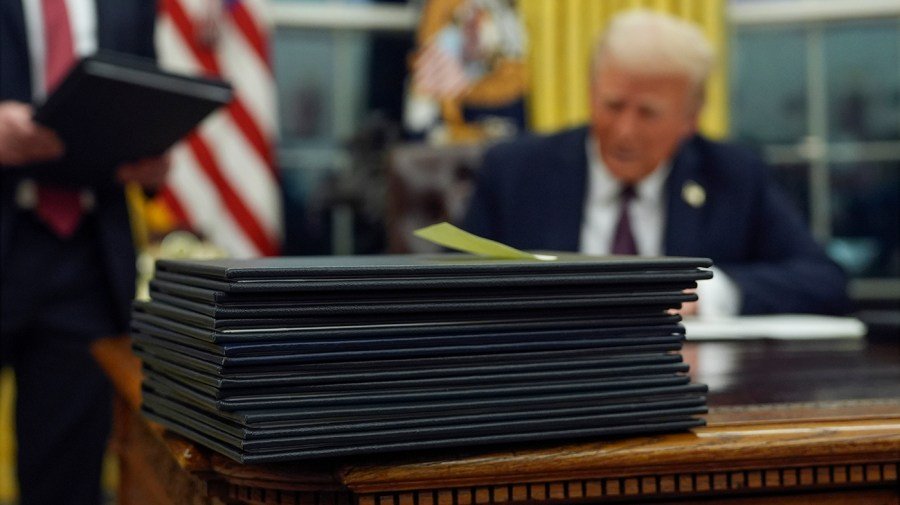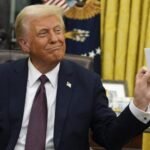President Trump signed a sweeping executive order late Monday during his first hours in office recognizing only two sexes and preventing government dollars from being spent on what his administration called “gender ideology.”
The executive order is part of a broader campaign promise to roll back trans rights and diversity and inclusion initiatives instituted by the Biden administration that Republicans argued went too far.
Here are five takeaways on Trump’s action.
It covers a lot of ground
Trump’s executive order is sweeping and at times vague, posing some questions about how it will be implemented.
The order, which pledges to restore “biological truth to the federal government,” defines male and female not by physical or chromosomal differences but by reproductive function.
Federal agencies should use the term “sex” instead of “gender,” according to the order, and remove statements, policies, and communications that “promote gender ideology,” which it defines in part as “an ever-shifting concept of self-assessed gender identity.”
Federal funds “shall not be used to promote gender ideology,” the order states.
It directs the secretaries of State and Homeland Security to prevent trans people from self-selecting their gender on official government documents such as visas and passports, which the State Department first allowed in 2021.
Trump’s order does not explicitly address passports with an “unspecified” gender marker, denoted by a single letter X, which the department began rolling out in 2022.
Monday’s executive order also tasks the incoming attorney general and secretary of Homeland Security to bar transgender people from government-funded single-sex facilities that best align with their gender identity, including prisons, migrant housing and domestic violence shelters. It directs the Bureau of Prisons to halt the use of federal dollars for gender-affirming care.
The order blocks requirements at government facilities and workplaces that transgender people be referred to using pronouns that match their gender identity, which Trump and administration officials have argued violates the First Amendment’s freedom of speech and religion.
It also directs the attorney general to provide explicit guidance on how the Supreme Court’s 2020 ruling in Bostock v. Clayton County, which determined that Title VII of the Civil Rights Act of 1964 protects workers from discrimination because of their gender identity or sexuality, may be applied to other federal statutes.
The order does not mention people born with intersex traits — natural variations in sex characteristics that differ from what is typically considered male or female.
It aims to fulfill several Trump campaign promises
Monday’s executive order seeks to make good on a number of Trump’s campaign promises related to transgender rights.
Trump had pledged to recognize only two sexes, male and female, as president and to prevent federal funds from being used to cover the costs of gender-affirming care for transgender inmates.
On the campaign trail, Trump had also railed against the use of pronouns — for individuals who are and who are not transgender. In an interview with Fox News’s Laura Ingraham in July, Trump said, “I don’t want pronouns” when asked for his own.
Monday’s order does not explicitly address access to gender-affirming care, which Trump has said he plans to heavily restrict. In 2022, Trump said he would ban transition-related care for minors and hand down harsh penalties to individuals and institutions that administer care to children and adolescents younger than 18. He has also threatened federal funding for hospitals that provide such care.
The order also does not touch on transgender athletes in women’s sports, which Trump has long opposed and attempted to ban during his first term. During a town hall event in October, Trump said he would “just ban” trans athletes from girls’ and women’s sports as president.
It will almost certainly be challenged in court
Monday’s executive order and other promised actions targeting transgender Americans will almost certainly face legal challenges in the months and years ahead. The American Civil Liberties Union (ACLU), which frequently challenges anti-LGBTQ laws in court, had already pledged to sue the Trump administration “wherever we can.”
In a statement late Monday, Lambda Legal, an LGBTQ civil rights organization, said it is similarly prepared to challenge Trump’s orders.
“While much of what is called for by the executive orders signed today will take time to implement, we will vigilantly monitor and be ready to challenge when they take effect,” said Kevin Jennings, the group’s CEO. “Lambda Legal has been at the forefront of these and other fights for more than 50 years – and we will not back down now.”
The order’s language reflects a rightward shift for Trump
The language used in Monday’s executive order reflects a sharp rightward shift in how a second Trump administration will approach issues related to gender identity, mirroring largely conservative talking points on sex and gender, namely that the two are indistinguishable and unchangeable.
Executive orders relating to transgender rights issued during Trump’s first term tended to use the word “transgender.” A 2017 order barring trans people from serving openly in the military, for example, uses the term on seven separate occasions.
Monday’s order, despite its explicit and direct impact on transgender and gender-nonconforming Americans, does not. It claims the Biden administration, by embracing gender identity as a fundamental and protected characteristic, permitted “the false claim that males can identify as and thus become women and vice versa.”
Trump’s order refers to trans women as “males,” language often used by Republican policymakers and media personalities to communicate to their audiences that transgender people do not exist. It orders federal agencies to cease communications that support the idea that gender is disconnected from sex and exists on a spectrum.
More orders impacting trans rights are coming
Senior administration officials said Monday’s order is “step one,” and more executive orders zeroing in on transgender rights are expected.
Trump has promised to ban gender-affirming care for transgender youth and prohibit trans student-athletes from competing on sports teams that match their gender identity.
At a Turning Point USA event in December, Trump said he plans to sign an executive order that bans transgender people from serving openly in the military, potentially restoring a policy that former President Biden repealed in 2021. Trump cleared the way to do just that on Monday by rescinding Biden’s order allowing trans people to serve.
Trump has also threatened “severe consequences,” including an elimination of federal funding, for schools with trans-inclusive curricula or transgender support plans.


